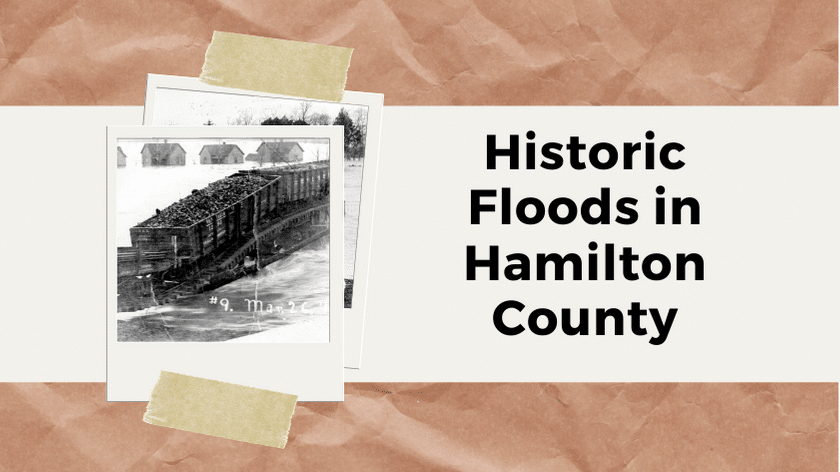By David Heighway, Hamilton County Historian
With all of the discussion about the “new normal” because of Covid-19, it set me to thinking about common memory and natural disasters. For many years, discussion of the 1918 flu epidemic was actually regarded as obscure and esoteric. It was often not included in history books or relegated to perhaps a single page in a chapter about World War I. Now, of course, statistics from that event are driving public policy. Cultural amnesia seems to follow a lot of natural disasters. For example, I looked at notable floods while researching Riverside Cemetery and came up with some surprising statistics.



We like to talk about the flood of 1913 as though it was a truly unique event. Yet of the top ten floods that have occurred in Hamilton County through its history, half of them have happened within the last twenty years. According to records at the National Weather Service, which go back to 1948, the top list is:
(1) 23.80 ft on 03/25/1913
(2) 21.86 ft on 07/10/2003
(3) 21.31 ft on 04/22/1964
(4) 21.29 ft on 12/31/1990
(5) 21.00 ft on 01/13/2005
(6) 20.65 ft on 05/14/2002
(7) 20.55 ft on 06/15/1958
(8) 20.42 ft on 01/24/1999
(9) 20.07 ft on 03/25/2007
(10) 19.99 ft on 09/04/2003
For comparison, the lowest girders on the Logan Street bridge are at 26.05 feet. The 2003 crest was within two feet of the 1913 crest. The next ten highest have the same ratio.
(11) 19.94 ft on 06/30/1957
(12) 19.86 ft on 03/01/2011
(13) 19.59 ft on 01/07/2005
(14) 19.43 ft on 04/19/2013
(15) 19.25 ft on 12/24/2013
(16) 19.20 ft on 01/14/2013
(17) 19.14 ft on 02/25/1985
(18) 19.11 ft on 06/04/1980
(19) 18.97 ft on 01/05/1950
(20) 18.96 ft on 03/06/1963
What’s more, this list doesn’t include floods prior to 1948. The flood that happened in January of 1937 was a huge event nationally. However, the Noblesville newspaper said that the crest was at 19 feet, which was lower than the 22 feet measured in 1913. Transposing that to modern National Weather Service measurement would make the 1937 flood 20.80 feet – not even in the top five. The reports reflect that. At the time, the newspaper mostly talked about helping refugees from places that were hit worse.
March of 1904 saw a flood that is now completely forgotten. There is no record of its height, except what we are able to deduce from later references. During the 1913 flood, local man Jonathan Kelly said that 1904 had been two feet lower, making it similar to the 2003 level. This estimate may have been high. The 1913 crest in Indianapolis was 4.4 feet higher than in 1904, and Anderson was 3.3 feet higher. Since Noblesville is roughly midway between those cities, the crest may have been somewhere between those numbers – perhaps around 20 feet. We do know that the cemetery was submerged and the Midland railroad bridge was destroyed.
The newspaper compared the flood in 1904 to floods in 1872, 1847, and 1823. There is no record of an 1872 White River flood anywhere. The writer was possibly referring to one that occurred in June of 1875. Again, there is no official measurement. We do know that it was lower than the recently-built Potters Bridge, and did a half million dollars’ worth of damage, (which would be equal to over ten million dollars today).
The 1847 flood happened in January. Augustus F. Shirts shared his memories of the flood in his 1901 history of the county “…shocks of corn and fodder, securely tied as it had been left in the fall before, were frequently seen floating down the river. I remember seeing a pig on one of these shocks floating past Noblesville. It was eating corn, apparently as unconcerned as it would have been in the barn lot at home. On another shock was a chicken floating quietly downstream.” Shirts said a part of Riverside Cemetery was covered by the water. In the 1923 Centennial issue of the Noblesville Ledger, Hugh Anthony Maker passed along stories told by Silas Hugh Moffitt, who witnessed the 1847 event. Moffitt surmised that 1913 was one or two feet higher than 1847, which would have made the earlier flood around 21 or 22 feet.
In the same Centennial issue, Maker passed on stories of the 1823 flood told to him by his grandmother. One story she told was of a cabin at Strawtown that had been built on the bottom land. Local Delaware Indians smiled as it was being constructed and pointed to marks on trees. The cabin builder realized what that meant when the flood came and the water rose to a few feet above the peak of the roof. Another story passed down was that William Conner had a mark somewhere on his property for the 1823 flood that was 2 ½ ft. higher than 1913, which would have made it around 26 feet!
Disasters are brought back into the public eye by popular culture like books, music, and movies. Everybody can talk about the Titanic or the Edmund Fitzgerald, but no one remembers the HMS Birkenhead, the SS Eastland, or the RMS Lancastria. Despite the seriousness of the events that are happening now, history can do funny things. Perhaps in 50 or 60 years, the most intense topics of today’s news may just be a plot twist in a historical novel or an answer in a trivia game.
